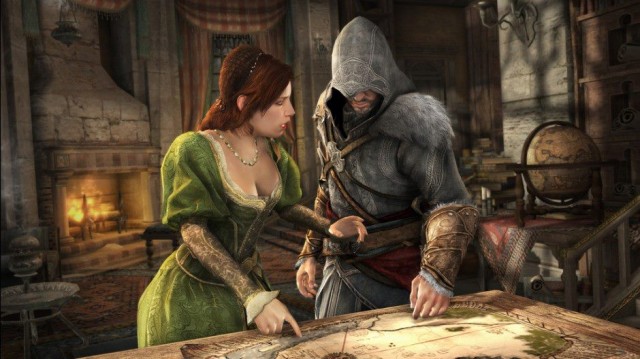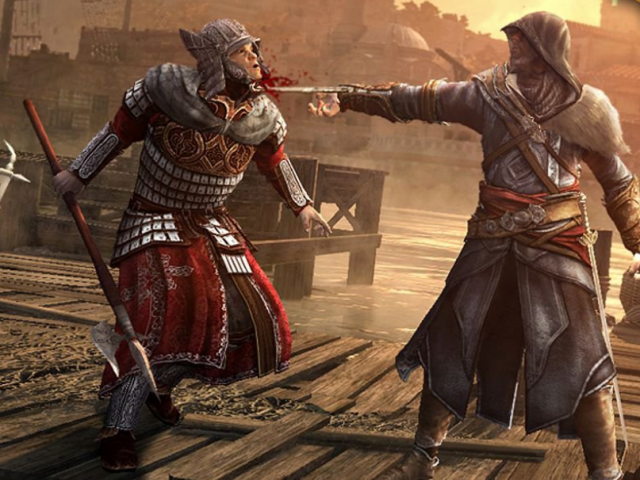 Assassin’s Creed: Revelations is the fourth title in Ubisoft’s award-winning, multi-platinum franchise. Developed by multiple internal studios around the globe and spanning more than 400 individual team members, the Assassin’s Creed series needs to sell better than most in order to offset its undoubtedly massive production costs. But can Ubisoft sustain such an ambitious annual business model while still keeping the sequels fresh and compelling?
Assassin’s Creed: Revelations is the fourth title in Ubisoft’s award-winning, multi-platinum franchise. Developed by multiple internal studios around the globe and spanning more than 400 individual team members, the Assassin’s Creed series needs to sell better than most in order to offset its undoubtedly massive production costs. But can Ubisoft sustain such an ambitious annual business model while still keeping the sequels fresh and compelling?
Each holiday season since 2009, the Assassin’s Creed team has provided a robust, open-ended game experience, easily rivaling anything the competition puts out once every few years. Assassin’s Creed: Revelations is the third and final entry following the life of Ezio Auditore da Firenze. As a brief recap, the original game featured Altaïr Ibn La’Ahad, an assassin during the Third Crusade. The second game switched to Ezio and bumped the setting up a few centuries to the Renaissance. Last year’s Brotherhood again starred Ezio, and as such Revelations effectively completes his trilogy. Both Ezio and Altaïr are the ancestors of Desmond Miles, a modern day assassin and the true main character of the franchise, who accesses their memories through a machine known as the Animus.
And it’s the ingenious Animus mechanic that truly gives Assassin’s Creed a ton of freedom to explore, both in terms of story and gameplay. It also gives the developers some breathing room with regards to things that would be considered flaws in a different game. Unlike many of today’s AAA titles, Assassin’s Creed is not striving for utter realism. In fact, it’s a very arcade-like experience, with no small amount of suspension of disbelief required. But that’s where the Animus comes in. The player is not directly living out the events of Ezio and Altaïr, but rather recreating them through a machine. These recreations are not perfect, nor do they have to be. It’s all quite akin to The Matrix. Where I might slam a game like Skyrim for having odd, realism-shattering glitches or poor design decisions, no one’s going to complain about seeing inhuman feats or the same cat twice inside the Matrix, and that applies to the world within the Animus as well. Except for the cat thing.
Teaching an old dog new tricks
This year’s title brings with it a number of additions, and a few subtractions. Revelations takes place primarily in Constantinople around 1511 AD, making the once-brazen and youthful Ezio approximately 50-years-old. By now fans should feel right at home in the virtual world, complete with towers to climb, viewpoints to synchronize, and merchant shops to renovate. But Constantinople feels like a step backward from Rome, which was the featured city in Assassin’s Creed: Brotherhood. There are no particularly memorable areas or landmarks, nor any countryside to roam. I felt the open rural spots in previous games gave the claustrophobic city game play a rest, so it’s unfortunate to see it removed here. This is also the first game in the series to not feature horses, though there are two sequences involving horse carriages, if that makes a difference (it doesn’t, and they’re annoying).
While Ezio may be the master, the assassins of Constantinople still have a few new tricks to teach him and gifts to give him, including the hookblade. The hookblade replaces one of Ezio’s hidden blades and opens up new gameplay opportunities such as latching on to climbable objects and ascending them more rapidly. After three games, this aging assassin has nothing to prove, and players will undoubtedly appreciate the expediency the hookblade allows for. Still, aside from riding the occasional zipline, you don’t ever actually need to use it. The way Assassin’s Creed games are designed, every jump or vertical obstacle is crafted to be overcome with Ezio’s natural (or some might say, supernatural) abilities, so the hookblade is really more of an optional tool. It does however allow for some pretty cool executions when fighting guards, but I’m genuinely left wondering if the hookblade was included merely as an afterthought.

The second major addition to Ezio’s already robust arsenal is customizable bombs. Using ingredients found all around the game world (they’re literally around every corner, it seems), you can craft a variety of lethal, tactical, and diversionary explosives. Although you may have heard Ubisoft touting 300 different bomb variations, the reality is nowhere near as impressive. In truth, there are less than a handful of different effect types for each of the three bomb classes. These can then be given different powder to determine the radius of the blast, and different fuses, such as a tripwire or time-delay. The thing is, like the hookblade, I found very little use for the bombs. Outside of a few specific instances, I’d actually have to go out of my way to use them, as a crossbow or throwing knife would usually be just as effective, if not more so. I suppose if a player really wanted to incorporate bombs into their play style they could, but I’d rather the game had been developed to take advantage of the new features slightly more. Still, if you want to go on a rampage or screw with the guards, the lamb’s blood bomb and caltrop mine can be quite entertaining.
Beyond those two additions, Ezio already has everything he needs from the previous games. His hidden blades, a sword, a dagger, a crossbow, throwing knives, poison darts, hidden pistol, and even parachutes. The combat is still extremely solid, but again there’s not much new here. You can now counter grab and counter steal, but outside of that it’s the same exact system as it was last year, which was nearly identical to the year before. That’s not necessarily a bad thing, but perhaps you’re starting to notice a trend with this game?

